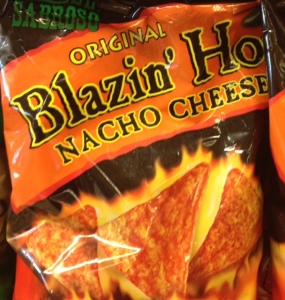A few months ago, charged with the task of shopping for my high school students’ snacks for their anger management group, I surveyed them for advice. Resounding opinion: we want “hot flamins.” Even when given the option of a variety pack, the regular potato chips were last picked (good thing chips don’t have feelings). On the students’ final day of group, we had a pizza party. So I let them haze me, putting some flamin’ hot cheetos on top of a slice of cheese pizza. After choking/crying a little bit, since Flamin hots are *not* intended for inhalation, at least the students were happy / proud of me.
Confession: maybe it was the burning sensation, the “Flamin’ Hot spice mix,” maybe it’s the monosodium glutamate, or just some magic combination created in a factory near us… but I kind of liked them. Like so many other things you never knew about, then “discovered,” I started noticing different iterations everywhere: Dinamitas, Blazin’ Hot, Fuego (Fire) flavored Takis…
Hint: You *might* be in trouble if a package depicts a tiny corn pouf that’s on fire / cartoon man with flames coming out of his mouth like a fire-breathing dragon. To be safe, have some yogurt nearby… just a little pearl of wisdom picked up from a London Indian restaurant where the waiter came to my rescue. Deep down, he knew this particular white lady was kidding herself thinking she could handle the spiciest dish on the menu.
Nerdy Fact: It might not be our fault that we enjoy such spefically engineered, “hyper-palatable” snack foods. By design, their ratio of fat, salt, and spiciness may cause our brains’ pleasure centers to react to them more strongly than other foods.
But also like so many other questionably-awesome things: Is eating these really in our best interest? And more specifically: do aggressive, sometimes trauamtized teenagers really need this in their lives? Perhaps not.
In fact, some school districts have banned “super spicy snacks,” which some emergency room doctors believe may lead to digestive distress. This article further explains that some spicy snacks have “come under fire” (haha) to to poor nutritional value and potential health risks.
What does this have to do with yoga? According to Ayurveda, an ancient healing system considered to be yoga’s “sister science,” summer is supposedly “Pitta” season. Hot, humid weather may make us a little more prone to anger, aggression, inflammation, impatience, and irritation. There might even be data to support this, even if it’s correlational (as the often-mentioned ice cream sales and violence statistics mentioned in social science classrooms everywhere).
Nerdy Fact: A team of economists and public policy researchers compiled 27 quantitative studies examining the we looked link between temperatures and conflict- ALL of which found an association between higher temperatures and violence.
So there might be something to this…
How to “Cool Down” from a yogic / Ayurvedic perspective:
1. Physical practice: work on gentle twists & side stretches. Avoid aggressive sports and intense exercise, especially during the hottest part of the day.
2. Breathing: try a cooling breath (Shitali, Sitkari), lengthen exhales, and exhaling through the mouth.
3. Diet: Avoid hot, salty, oily, and pungent foods; limit caffeine and alcohol. Eat more sweet and bitter foods.
4. Other suggestions: stay cool, manage stress, avoid conflict & overworking.
(And probably cut down on the flamin’ hots!)



